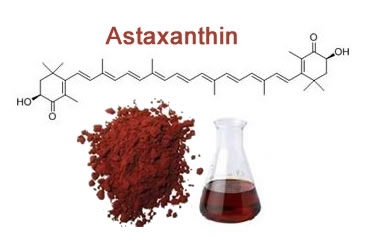Astaxanthin is a carotenoid, a chemical found naturally in certain plants and animals. A type of algae makes astaxanthin. This algae is used as a source for the astaxanthin in supplements.
Some types of seafood also contain astaxanthin.
Astaxanthin gives salmon and lobster their reddish color, and flamingo feathers their pink hue.

Why do people take astaxanthin?
Astaxanthin is an antioxidant. That means it helps reduce a natural process in your body called oxidation. This process may play a role in many diseases and changes such as:
- Aging
- Cancer
- Heart disease
- Eye diseases like cataracts and macular degeneration
- Alzheimer’s disease
- Parkinson’s disease
Astaxanthin can also reduce inflammation. It might be useful as a treatment for problems that involve inflammation, such as:
- Rheumatoid arthritis
- Carpal tunnel syndrome
Laboratory research has found that an extract from algae that makes astaxanthin slowed the growth of breast and skin cancer cells.
Astaxanthin might help the heart in a number of ways, as well. It may be helpful in preventing plaque buildup in arteries in the heart.
It may also help protect heart muscle from damage from lack of oxygen. This can happen during a heart attack.
Also, by reducing oxidation in the brain, it may protect against Alzheimer’s and Parkinson’s diseases.
Astaxanthin may reduce the growth of H. pylori bacteria, which cause peptic ulcers. It may also help protect against kidney damage from diabetes. And it may stimulate the immune system.

However, more research is needed before astaxanthin can be recommended for any of these uses.
Supplement makers may suggest varying amounts of astaxanthin for different purposes. Most of the small research studies to date have used between 2 mg and 24 mg daily. However, optimal doses of astaxanthin have not been set for any condition. Quality and active ingredients in supplements may vary widely. This makes it difficult to set a standard dose.
Can you get astaxanthin naturally from foods?
One of the largest sources of astaxanthin is in certain types of marine algae.
Astaxanthin is also found in several types of seafood, including:
- Salmon
- Rainbow trout
- Shrimp
- Lobster
Four ounces of sockeye salmon contains about 4.5 milligrams of astaxanthin.
What are the risks of taking astaxanthin?
Side effects. Some laboratory studies have shown astaxanthin may hinder an enzyme called 5-alpha-reductase. As a result, it could keep testosterone from changing into the hormone DHT in the body. It’s unclear what effect this may have, but prescription medicines that affect the same enzyme may cause side effects, such as:
- Lower libido
- Male breast growth
- Erectile dysfunction
One small study showed astaxanthin combined with saw palmetto actually increased testosterone, which could help libido. More research is needed to better understand astaxanthin’s effects on hormones.
Astaxanthin may also lower blood pressure and calcium levels.
Note: Avoid taking astaxanthin if you’re allergic or sensitive to it. Also avoid astaxanthin if you’re allergic or sensitive to:
- Similar carotenoids such as canthaxanthin
- A source of astaxanthin, such as the algae that produces it
- Drugs that inhibit 5-alpha-reductase like finasteride (Propecia, Proscar) or dutasteride (Avodart, Jalyn)
- Women who are pregnant or might become pregnant should avoid astaxanthin.
Astaxanthin may increase your immune function, so use caution when taking it if you:
- Have autoimmune problems
- Are taking drugs to suppress your immune system
Also be cautious using astaxanthin if you have:
- Low calcium
- Low blood pressure
- Osteoporosis
- A problem with your parathyroid glands
- Hormone problems
Interactions: Use with caution if you are taking a drug that affects hormones, such as a 5-alpha-reductase inhibitor, or if you are on a drug for high blood pressure.
Tell your doctor/GP about any supplements you’re taking, even if they’re natural. That way, your doctor can check on any potential side effects or interactions with any medications.
If you have any other question please leave me a comment below.





 Em Português
Em Português En Español
En Español